
Cultural Crossroads: The Supernatural in Diverse Societies
7 min read Explore how diverse societies interpret the supernatural at cultural crossroads worldwide. (0 Reviews)
Cultural Crossroads: The Supernatural in Diverse Societies
The supernatural has long fascinated humankind, weaving an intricate tapestry of myths, spirits, and unexplained phenomena that cross continents and cultures. At the crossroads where societies meet and mingle, supernatural beliefs illuminate how different peoples understand existence beyond the physical world. From ancient animistic rituals in Africa to ghostly folklore in East Asia, the supernatural reflects not just mystery but the heart of cultural identity.
In this exploration, we delve deep into how diverse societies embrace the supernatural, uncovering the interplay between cultural heritage, spiritual beliefs, and modern perceptions.
The Supernatural as Cultural Lens
At its core, supernatural beliefs serve as a lens for societies to interpret their world — addressing existential questions, enforcing moral codes, and connecting with unseen forces.
African Ancestral Connections
In many African communities, the supernatural centers on ancestral spirits and their continuing presence. For example, the Yoruba people of Nigeria believe in "Egungun," a masquerade representing ancestral spirits who guide and protect the living. These annual Egungun festivals blend dance, costume, and spiritual communion, emphasizing the enduring influence of the cosmos in everyday life.
John Mbiti, a Kenyan philosopher, encapsulates this view: "Africa is a world richly-peopled with beings of another dimension — the spirits of the ancestors who live with us, in society, and watch over their offspring."
This supernatural connection transcends death, providing a framework for social cohesion and ethical behavior.
East Asian Ghosts and Spirits
In East Asia, the supernatural often focuses on spirits trapped between worlds, reflecting societal tensions and cultural beliefs. Japanese folklore teems with "yōkai" (supernatural beings) and "obake" (ghosts) representing moral lessons or historical tragedies. For instance, the story of the "Okiku Doll" in Japan carries themes of loyalty and vengeance, fueling ghost stories passed for generations.
Similarly, the Chinese belief in "Hungry Ghosts"—spirits deprived of proper rites—demonstrates how ancestor worship and supernatural fears coexist. Festivals like the Chinese Ghost Festival involve ritual offerings to appease these wandering souls, reflecting a complex dialogue between the living and the dead.
Indigenous Americas: Nature and Spirit Intertwined
For many Indigenous American cultures, the supernatural permeates the natural world. The Navajo's concept of "Diné Bahane’" — the story of the emergence and creation — integrates supernatural beings as sources of cosmic order. Spirits like the "Yéʼiitsoh" (giant warrior spirits) embody both protective and ominous forces.
Similarly, Latin American folk saints, such as "La Llorona"—a weeping woman ghost mourned for lost children—blend indigenous beliefs with colonial Catholicism, symbolizing cultural survival through supernatural narratives.
Cross-Cultural Influences and Supernatural Syncretism
The crossroads of cultures often generate syncretic supernatural beliefs, blending indigenous traditions with foreign or colonial influences.
Vodou: A Syncretic Spirituality
Haitian Vodou exemplifies supernatural syncretism, merging West African spiritual practices with Catholic iconography. In Vodou ceremonies, lwa (spirits) possess practitioners to convey divine messages, serving as intermediaries between humans and the spirit world.
Historian Karen McCarthy Brown emphasizes Vodou's resilience: "Vodou is not just a religion; it’s the soul of the Haitian people, merging tragedy, hope, and spirituality in the supernatural realm."
Spiritualism and Western Esotericism
In the 19th and 20th centuries, Western spiritualism influenced supernatural understanding globally, often intersecting with traditional beliefs. The rise of séances, spirit communication, and mediums expanded supernatural exploration beyond cultural boundaries, creating hybrid practices.
For example, in Brazil, Afro-Brazilian religions like Candomblé absorbed aspects of Western spiritualism while maintaining African roots.
Supernatural in Modern Societies: Science and Tradition
Technology, globalization, and skepticism challenge traditional supernatural beliefs while simultaneously fostering new interpretations.
Ghost Hunting and Technology
Modern ghost hunting utilizes infrared cameras, electromagnetic sensors, and EVP (Electronic Voice Phenomena) recordings. This reflects society’s attempt to bridge ancient beliefs with scientific inquiry.
Organizations like The Atlantic Paranormal Society (TAPS) popularized ghost hunting through media, creating a cultural revival of supernatural interest worldwide.
Media Influence and Cultural Identity
Movies, books, and video games propagate supernatural themes adapted from various cultures, increasing visibility but also risking cultural appropriation or misinterpretation.
However, this media also fosters respect and curiosity. For instance, the global popularity of Studio Ghibli films often inspired by Japanese yokai stories enlightens audiences on cultural supernatural traditions.
Conclusion: Embracing the Supernatural as Cultural Heritage
The supernatural is far more than inexplicable phenomena; it is a rich cultural heritage that reveals how societies make sense of life, death, morality, and the universe. At the crossroads of cultures, supernatural beliefs offer windows into history, values, and identity.
Understanding these diverse perspectives not only enriches our knowledge of global cultures but also invites us to appreciate mysteries that transcend borders. In a rapidly modernizing world, these ancient traditions remind us that the unseen remains an integral part of human existence.
Exploring the supernatural in diverse societies inspires respect, curiosity, and the recognition that the mystical and the cultural are inextricably bonded across humanity.
Rate the Post
User Reviews
Popular Posts





















